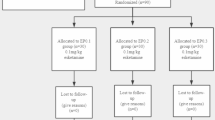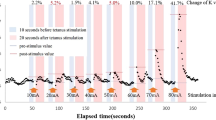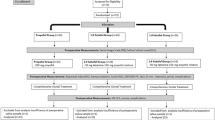Abstract
Aim:
To examine individual patient's demographic parameters and clinical variables related to return of consciousness (ROC) and the pharmacodynamic relationship between propofol effect-site concentration (Ce) and ROC from propofol-remifentanil anesthesia.
Methods:
Ninety-four patients received propofol-remifentanil anesthesia using the effect-site target-controlled infusion (TCI) system. All clinical events were noted, and variables possibly related to propofol Ce at ROC were examined using linear correlation analyses. Pharmacodynamic modeling incorporating covariates was performed using NONMEM (Nonlinear Mixed Effects Modeling) VII software.
Results:
The Ce values of propofol at loss of consciousness (LOC) and ROC were 4.4±1.1 μg/mL and 1.1±0.3 μg/mL, respectively. Age was negatively correlated with propofol Ce at ROC (r=−0.48, P<0.01). Including age as a covariate in Ce50 (the effect-site concentration associated with 50% probability of return of consciousness) and λ (the steepness of the concentration-versus-response relationship) significantly improved the performance of the basic model based on the likelihood ratio test, with a significant decrease in the minimum value of the objective function. The Ce50 in 25-, 50-, and 75-year-old patients was predicted to be 1.38, 1.06, and 0.74 μg/mL, respectively. The λ in 25-, 50-, and 75-year-old patients was predicted to be 12.23, 8.70, and 5.18, respectively.
Conclusion:
Age significantly affects the relationship between propofol Ce and ROC, and pharmacodynamic modeling including age could lead to better predictions of ROC during emergence from propofol-remifentanil anesthesia.
Similar content being viewed by others
Log in or create a free account to read this content
Gain free access to this article, as well as selected content from this journal and more on nature.com
or
References
Larsen B, Seitz A, Larsen R . Recovery of cognitive function after remifentanil–propofol anesthesia: a comparison with desflurane and sevoflurane anesthesia. Anesth Analg 2000; 90: 168–74.
Nunes CS, Ferreira DA, Antunes L, Amorim P . Clinical variables related to propofol effect-site concentrations at recovery of consciousness after neurosurgical procedures. J Neurosurg Anesthesiol 2005; 17: 110–4.
Wessén A, Persson PM, Nilsson A, Hartvig P . Concentration-effect relationships of propofol after total intravenous anesthesia. Anesth Analg 1993; 77: 1000–7.
Chortkoff BS, Eger EI 2nd, Crankshaw DP, Gonsowski CT, Dutton RC, Ionescu P . Concentrations of desflurane and propofol that suppress response to command in humans. Anesth Analg 1995; 81: 737–43.
Schnider TW, Minto CF, Gambus PL, Andresen C, Goodale DB, Shafer SL, et al. The influence of method of administration and covariates on the pharmacokinetics of propofol in adult volunteers. Anesthesiology 1998; 88: 1170–82.
Schnider TW, Minto CF, Shafer SL, Gambus PL, Andresen C, Goodale DB, et al. The influence of age on propofol pharmacodynamics. Anesthesiology 1999; 90: 1502–16.
Minto CF, Schnider TW, Egan TD, Youngs E, Lemmens HJ, Gambus PL, et al. Influence of age and gender on the pharmacokinetics and pharmacodynamics of remifentanil. I. Model development. Anesthesiology 1997; 86: 10–23.
Minto CF, Schnider TW, Shafer SL . Pharmacokinetics and pharmacodynamics of remifentanil. II. Model application. Anesthesiology 1997; 86: 24–33.
Chernik DA, Gillings D, Laine H, Hendler J, Silver JM, Davidson AB, et al. Validity and reliability of the Observer's Assessment of Alertness/Sedation Scale: study with intravenous midazolam. J Clin Psychopharmacol 1990; 10: 244–51.
Lu W, Ramsay JG, Bailey JM . Reliability of pharmacodynamic analysis by logistic regression: mixed-effects modeling. Anesthesiology 2003; 99: 1255–62.
Dahaba AA, Zhong T, Lu HS, Bornemann H, Liebmann M, Wilfinger G, et al. Geographic differences in the target-controlled infusion estimated concentration of propofol: bispectral index response curves. Can J Anaesth 2011; 58: 364–70.
Masui K, Upton RN, Doufas AG, Coetzee JF, Kazama T, Mortier EP, et al. The performance of compartmental and physiologically based recirculatory pharmacokinetic models for propofol: a comparison using bolus, continuous, and target-controlled infusion data. Anesth Analg 2010; 111: 368–79.
Nunes CS, Ferreira DA, Antunes L, Lobo F, Santos IA, Amorim P . Individual effect-site concentrations of propofol at return of consciousness are related to the concentrations at loss of consciousness and age in neurosurgical patients. J Clin Anesth 2009; 21: 3–8.
Nho JS, Lee SY, Kang JM, Kim MC, Choi YK, Shin OY, et al. Effects of maintaining a remifentanil infusion on the recovery profiles during emergence from anaesthesia and tracheal extubation. Br J Anaesth 2009; 103: 817–21.
Iwakiri H, Nagata O, Matsukawa T, Ozaki M, Sessler DI . Effect-site concentration of propofol for recovery of consciousness is virtually independent of fentanyl effect-site concentration. Anesth Analg 2003; 96: 1651–5.
Kazama T, Ikeda K, Morita K, Sanjo Y . Awakening propofol concentration with and without blood-effect site equilibration after short-term and long-term administration of propofol and fentanyl anesthesia. Anesthesiology 1998; 88: 928–34.
McCormack J, Mehta D, Peiris K, Dumont G, Fung P, Lim J, et al. The effect of a target controlled infusion of propofol on predictability of recovery from anesthesia in children. Paediatr Anaesth 2010; 20: 56–62.
Iwakiri H, Nishihara N, Nagata O, Matsukawa T, Ozaki M, Sessler DI . Individual effect-site concentrations of propofol are similar at loss of consciousness and at awakening. Anesth Analg 2005; 100: 107–10.
Barakat AR, Sutcliffe N, Schwab M . Effect site concentration during propofol TCI sedation: a comparison of sedation score with two pharmacokinetic models. Anaesthesia 2007; 62: 661–6.
Acknowledgements
This work was supported in part by the Yonsei University Research Fund of 2009.
The authors thank Dr Go Un ROH MD (Department of Anesthesiology and Pain Medicine and Anesthesia and Pain Research Institute, Yonsei University College of Medicine, Seoul, Korea) for her assistance with analysis of the data.
Author information
Authors and Affiliations
Corresponding author
Rights and permissions
About this article
Cite this article
Koo, Bn., Lee, Jr., Noh, Gj. et al. A pharmacodynamic analysis of factors affecting recovery from anesthesia with propofol-remifentanil target controlled infusion. Acta Pharmacol Sin 33, 1080–1084 (2012). https://doi.org/10.1038/aps.2012.85
Received:
Accepted:
Published:
Issue date:
DOI: https://doi.org/10.1038/aps.2012.85
Keywords
This article is cited by
-
Predicting the optimal concentration of remifentanil for skull pin fixation with hemodynamic and analgesia nociception index monitoring
Scientific Reports (2024)
-
Monitoring of anesthetic depth and EEG band power using phase lag entropy during propofol anesthesia
BMC Anesthesiology (2020)
-
Propofol target-controlled infusion modeling in rabbits: Pharmacokinetic and pharmacodynamic analysis
Journal of Huazhong University of Science and Technology [Medical Sciences] (2016)



